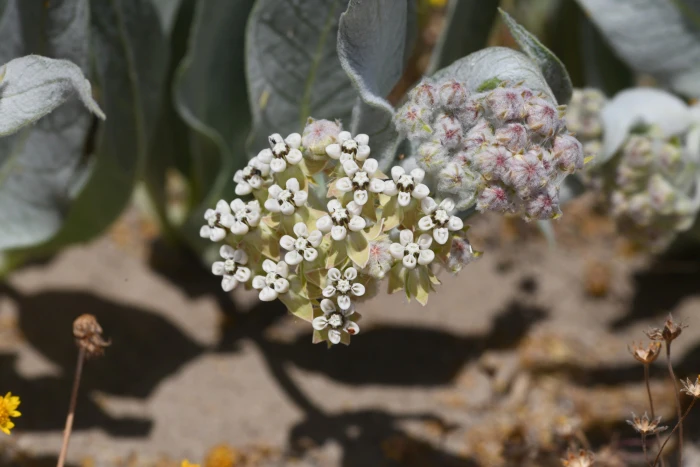Woolly Milkweed
(Asclepias vestita)
Woolly Milkweed (Asclepias vestita)
/
/

Chloe and Trevor Van Loon
CC BY 4.0
Image By:
Chloe and Trevor Van Loon
Recorded By:
Copyright:
CC BY 4.0
Copyright Notice:
Photo by: Chloe and Trevor Van Loon | License Type: CC BY 4.0 | License URL: http://creativecommons.org/licenses/by/4.0/ | Rights Holder: Chloe and Trevor Van Loon | Publisher: iNaturalist | Date Created: 2023-05-19T13:08:08-07:00 |

























Estimated Native Range
Climate Requirements for Randallstown, Maryland
| This Plant | Your Site | Plant Suitability for Your Location | ||
|---|---|---|---|---|
| • Precipitation | 3" - 45" | 45" | Aquatic | Aquatic |
| • High Temp. | 77°F - 109°F | 86°F | Your summer temperatures are normal for this plant. | Excellent |
| • Low Temp. | 26°F - 43°F | 23°F | Your winter temperatures may be too cold for this plant | Too cold |
This plant may not grow well at your location - your precipitation is too high.
Summary
Asclepias vestita, commonly known as Woolly Milkweed or Woollypod Milkweed, is a perennial herb native to California, specifically thriving in arid regions such as desert washes, dry slopes, and plains, as well as in the Central Valley’s grasslands. It typically grows at a moderate rate to a height of 1-2.5 feet (0.3-0.8 meters) and is characterized by its woolly, gray-green foliage and stems. The plant produces clusters of white to pink flowers that are quite showy and bloom in the summer, attracting a variety of pollinators, including bees and butterflies. Notably, it serves as a host plant for the Monarch butterfly, providing a food source for the larvae.
Woolly Milkweed is valued for its drought tolerance and ability to thrive in challenging environments, making it an excellent choice for xeriscaping and naturalized areas in dry climates. It is also used in pollinator gardens due to its attractiveness to butterflies. In cultivation, it requires full sun exposure and prefers fast-draining sandy or loamy soils. It is a low-maintenance plant that needs minimal water once established, reflecting its adaptation to arid conditions. Gardeners should be aware that, like other milkweeds, it contains toxic compounds that can be harmful if ingested by humans or animals.CC BY-SA 4.0
Woolly Milkweed is valued for its drought tolerance and ability to thrive in challenging environments, making it an excellent choice for xeriscaping and naturalized areas in dry climates. It is also used in pollinator gardens due to its attractiveness to butterflies. In cultivation, it requires full sun exposure and prefers fast-draining sandy or loamy soils. It is a low-maintenance plant that needs minimal water once established, reflecting its adaptation to arid conditions. Gardeners should be aware that, like other milkweeds, it contains toxic compounds that can be harmful if ingested by humans or animals.CC BY-SA 4.0
Plant Description
- Plant Type: Herb
- Height: 1-2.5 feet
- Width: 2-3 feet
- Growth Rate: Moderate
- Flower Color: White, Pink
- Flowering Season: Summer
- Leaf Retention: Deciduous
Growth Requirements
- Sun: Full Sun
- Water: Low
- Drainage: Fast
Common Uses
Butterfly Garden, Deer Resistant, Drought Tolerant, Low Maintenance
Natural Habitat
Native to arid regions such as desert washes, dry slopes, plains, and the Central Valley’s grasslands in California
Other Names
Common Names: Woollypod Milkweed
Scientific Names: Asclepias vestita, Asclepias vestita var. vestita
GBIF Accepted Name: Asclepias vestita